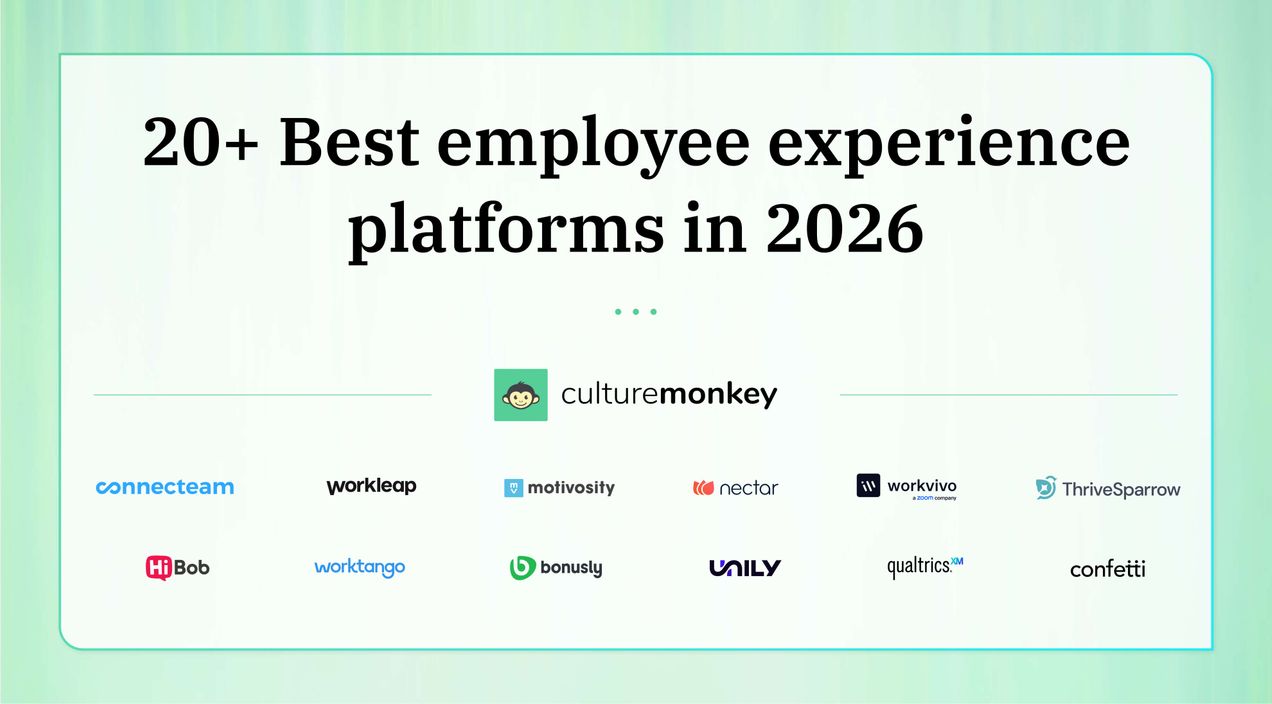Employee experience best practices: Strategies for engaging and retaining talent in 2025

As the renowned author Simon Sinek once said, “Customers will never love a company until the employees love it first.” This powerful quote emphasizes that a positive employee experience directly influences customer satisfaction and business success. To stay ahead, businesses must prioritize creating environments where employees feel valued, supported, and empowered.
In this guide, we will explore proven strategies to enhance the employee experience, from recruitment and onboarding to performance management and development.
By making employee experience a top priority, organizations can build a thriving workforce that drives both individual and organizational growth in 2025 and beyond.
What is employee experience?
Employee experience encompasses every interaction an employee has with their employer, shaping their journey from recruitment to departure. A successful employee experience strategy goes beyond just offering a paycheck—it creates a workplace culture where employees feel valued, supported, and aligned with the company’s mission.
When employees feel hard-pressed and unsupported, job satisfaction diminishes, leading to disengagement and increased employee turnover.
To improve the employee experience, companies must implement employee experience initiatives that focus on gathering employee feedback through employee engagement surveys and digital employee experience tools. These insights can help identify pain points and enhance the work environment.
A positive experience boosts employee morale and directly impacts business outcomes, fostering a motivated workforce. When employees feel heard and valued, they are more likely to stay and contribute to achieving the company’s mission. Prioritizing employee experience is essential for reducing turnover and building a thriving, productive workplace.
Why should employee experience be your top priority?
The employee journey begins with the hiring process, and it’s essential that candidates feel the process is fair and transparent. Gathering employee feedback through tools like the employee net promoter score (eNPS) allows organizations to assess employee satisfaction and improve processes. Offering robust training programs and supporting professional development ensures employees’ growth aligns with the company’s values, which boosts engagement.
When employees feel supported in both their professional and personal lives, they contribute to a stronger customer experience. Ultimately, enhancing the employee experience has a direct impact on key performance indicators (KPIs) such as employee retention, productivity, and business outcomes.
Developing an employee experience strategy
To successfully enhance the employee experience, it’s essential to develop a comprehensive strategy that aligns with the needs and expectations of your workforce. Here are the key components of a successful employee experience strategy:
Create a strong Employee Value Proposition (EVP)
An employee value proposition (EVP) clearly communicates the benefits employees can expect from working at your company. It should reflect your company culture, mission, and how the organization supports employees’ personal and professional lives. A compelling EVP will encourage employees to stay engaged and feel valued, boosting retention and satisfaction.
Ensure a fair hiring process
The hiring process should feel fair and transparent to potential candidates. From the application to the interview, every step should align with your company’s values and promote inclusivity. A positive first interaction helps set the stage for an exceptional employee experience, making new hires feel welcomed and valued from day one.
Encourage employee feedback and engagement
Regularly gather employee feedback through surveys, focus groups, and one-on-one meetings to understand their needs and concerns. Engaged employees are more likely to feel motivated and perform well. Create an open environment where employees feel comfortable sharing feedback, helping improve overall employee performance and satisfaction.
Offer opportunities for development and growth
Employees want to feel that they are growing professionally. By providing training programs and career advancement opportunities, you support their long-term development. This not only improves employee performance but also helps them connect with their work, making them more committed to their roles and the company.
Leverage technology to enhance the employee experience
Implementing employee experience tools and platforms can streamline communication, gather employee feedback, and track key performance indicators (KPIs). Employee performance software can play a crucial role here, enabling organizations to monitor progress, identify areas for improvement, and support employees in achieving their goals.
Additionally, these tools provide valuable insights into employee satisfaction, enabling HR leaders to make data-driven decisions that improve the work environment and the relationships employees build with the company.
What are the 7 stages of the employee life cycle?
The employee life cycle outlines the journey an employee takes from their first interaction with the company to their eventual departure. Understanding this cycle is essential for improving the employee experience at key touchpoints. Here are the seven stages of the employee life cycle:
- Attraction: The recruitment process where potential employees first learn about your company’s values and culture. This is a critical stage to connect employees with your company’s mission.
- Recruitment: Candidates apply for positions and undergo interviews. Ensuring the hiring process feels fair can help set positive expectations for job roles.
- Onboarding: The onboarding process introduces new hires to the organization. A well-designed onboarding process ensures employees strongly agree with the company’s values and feel equipped to succeed in their roles.
- Development: Providing career development opportunities is essential in this stage. Employees are offered professional development opportunities and training programs to grow in their roles.
- Engagement: Engaged employees feel immersed in their roles. Managers should encourage regular check-ins and feedback to keep employees engaged and aligned with job expectations.
- Retention: Keeping employees happy is crucial in this stage. Business leaders should implement strategies to retain talent and reduce disengaged employees, as turnover can cost companies significantly.
- Separation: Employees leave the organization, either voluntarily or involuntarily. This final stage is an opportunity to gather feedback and stay up to date on improving the overall employee experience framework for future employees.
How to improve employee experience at each stage of the employee life cycle?

Attraction
To attract top talent, ensure that your employer branding accurately reflects your company culture and values. Showcase your physical work environment, commitment to employee well-being, and career growth opportunities on social media, job postings, and your website. Highlight how your company supports both internal customers (employees) and external customers, emphasizing the benefits of working in a supportive and dynamic workplace.
Recruitment
Streamline your hiring process to make it efficient and transparent. Communicate clearly with candidates and keep them informed throughout. Providing a seamless, respectful candidate experience builds trust and fosters positive relationships from the outset. Make sure to include frontline workers' feedback to ensure a realistic depiction of job roles and expectations.
Onboarding
A strong onboarding program sets the tone for the employee experience. Provide new hires with the tools, resources, and information they need to succeed. Integrating new employees into team engagement activities and keeping them updated with company news creates a sense of belonging and helps them feel welcomed and supported from day one.
Development
Offer continuous career growth opportunities to all employees. Encourage learning through mentorship programs, online training, and access to industry conferences. This helps employees stay engaged in their roles and allows them to develop skills that will enhance their contributions to the company and their career path.
Engagement
Foster a culture of open communication, encouraging regular check-ins with managers and conducting pulse surveys. Create opportunities for employees to voice their opinions and share feedback, and ensure that the physical environment supports team collaboration. Recognize achievements and address concerns promptly to maintain a motivated workforce, improving overall employee satisfaction.
13 Top employee experience best practices to follow in 2025

As we approach 2025, businesses need to stay ahead by implementing the following 13 employee experience best practices:
1. Foster a positive work culture
A positive workplace culture is essential for creating a positive employee experience. Focus on cultivating a company culture that promotes collaboration, inclusivity, and open communication. When employees feel valued and supported, they’re more engaged and productive.
2. Leverage employee experience tools
Technology plays a critical role in improving the employee journey. Implement digital employee experience tools to gather real-time feedback, measure engagement, and streamline processes like performance reviews. Tools such as time and attendance software can play a vital role in simplifying team management, providing accurate time tracking, ensuring employees have clear visibility into their schedules, and reducing potential conflicts
These tools enhance communication and enable leaders to identify and address issues quickly, contributing to happy employees and fostering a better overall experience.
3. Offer flexible work options
In today’s job market, employees expect flexibility in balancing their professional and personal lives. Providing remote or hybrid work options demonstrates trust and supports a healthier work-life balance. Flexible work arrangements improve the employee experience and make your organization more attractive to top talent.
4. Recognize and reward employees
Regular recognition for achievements boosts morale, engagement, and loyalty. Acknowledging contributions, whether through rewards, promotions, or public appreciation, fosters a culture of recognition. Employees who feel valued are more likely to stay motivated and aligned with company goals.
5. Invest in employee well-being
Supporting employee well-being goes beyond physical health. Provide wellness programs, mental health support, and resources to help employees balance their work and personal lives. Prioritizing well-being creates happy employees who are more productive and less likely to leave the organization.
6. Encourage career development
Career growth is a key driver of employee satisfaction. Offer training programs, mentoring, and clear pathways for advancement to help employees develop professionally. A robust onboarding process that includes career development opportunities ensures new hires start their journey with a positive experience.
7. Use staff experience surveys
Regularly gather feedback through staff experience surveys to understand employee satisfaction and identify areas for improvement. This feedback is invaluable for shaping policies and initiatives that truly address employee needs, leading to a more positive workplace culture.
8. Create an inclusive environment
Promote diversity, equity, and inclusion to ensure all employees feel valued and respected. An inclusive company culture fosters innovation and enhances collaboration, ultimately improving the employee experience and customer experience alike.
9. Provide competitive compensation
In a competitive job market, offering attractive salary and benefits packages is essential. Competitive compensation not only attracts top talent but also retains your best employees by showing them their worth is recognized.
10. Focus on leadership development
Train leaders to be empathetic and effective in managing their teams. Strong leadership is vital for maintaining a positive workplace culture and ensuring that employees feel supported throughout their journey.
11. Encourage open communication
Create a workplace culture where employees feel comfortable sharing ideas and concerns without fear of judgment. Open communication helps improve the employee experience by fostering trust and transparency.
12. Invest in technology
Enhance the employee journey by adopting innovative technologies like employee experience platforms. These tools streamline workflows, provide valuable insights, and ensure a seamless digital employee experience.
13. Measure progress regularly
Continuously track employee experience metrics and adjust strategies based on data. Regular measurement ensures that your initiatives align with employee needs and contribute to a more positive employee experience.
The impact of remote and hybrid work on employee experience
The shift to remote and hybrid work models has revolutionized the employee journey, offering both benefits and challenges. While employees value the flexibility to manage personal lives alongside professional responsibilities, these arrangements can sometimes lead to feelings of isolation, reduced team engagement, and communication gaps.
One significant advantage of these models is their ability to improve the employee experience by allowing a better work-life balance. Employees can create a routine that suits their needs, contributing to greater job satisfaction and productivity. However, without a positive workplace culture and the right digital tools, the employee experience can suffer.
To address these challenges, organizations should invest in creating a cohesive digital employee experience. Providing the necessary tools and technologies ensures employees can collaborate effectively, whether in-office or remote. Encouraging managers to facilitate regular check-ins, share company news, and foster open communication helps connect employees and reduce feelings of isolation.
Team engagement activities, both virtual and in-person, also play a vital role. These initiatives strengthen relationships and create a sense of belonging, even in dispersed teams. Additionally, offering mental health resources demonstrates a commitment to employee well-being, further enhancing their overall experience.
By focusing on these strategies, businesses can not only retain happy employees but also build a resilient and adaptable workforce, ready to thrive in a hybrid work environment.
How to measure employee experience throughout their journey with your organization?

Measuring employee experience is crucial to understanding how your workforce feels and identifying areas for improvement. Here are some effective ways to measure employee experience:
- Surveys: Conduct regular employee experience surveys to gather insights into how employees feel about their workplace. These comprehensive surveys can assess satisfaction, engagement, and alignment with company values. By analyzing results, organizations can identify trends, strengths, and areas for improvement, ensuring that strategies align with employee needs and fostering a positive workplace culture.
- Pulse Surveys: Pulse surveys are short, targeted surveys conducted frequently to capture real-time employee sentiment. These allow businesses to address emerging issues promptly and measure the impact of recent changes or initiatives. By staying updated on employee feelings, HR leaders can proactively improve the employee experience and maintain engagement.
- One-on-one meetings: Regular check-ins between employees and managers are invaluable for building trust and fostering open communication. These meetings allow employees to share feedback, clarify job expectations, and receive support. They create a personal connection that strengthens the relationship employees build with their managers and helps address challenges early.
- Exit interviews: Exit interviews provide critical insights from departing employees. By understanding their reasons for leaving, organizations can identify recurring patterns, such as dissatisfaction with leadership, lack of career growth, or workplace culture issues. This information is essential for refining employee experience strategies and reducing turnover.
Significance of staff experience surveys in measuring employee experience at work
Staff experience surveys are indispensable for understanding and improving the employee journey. These tools provide a structured way for organizations to gather real-time feedback on critical aspects of work life, including job satisfaction, workplace culture, leadership effectiveness, and the physical and digital work environment.
By engaging employees regularly through these surveys, organizations demonstrate that they value their workforce's opinions, fostering trust and transparency.
One significant advantage of these surveys is their ability to identify specific areas where improvements can enhance the employee experience. For instance, data might reveal that employees feel disengaged due to unclear job expectations or inadequate career development opportunities.
Organizations can use this feedback to implement targeted strategies that directly address these concerns, leading to a more positive workplace culture and happier employees.
To further enhance the value of staff experience surveys, companies can integrate advanced employee experience platforms. These tools go beyond basic feedback collection by tracking metrics like employee engagement, well-being, and satisfaction. They also provide actionable insights through dashboards and trend analysis, helping HR leaders and managers stay up-to-date with workforce dynamics.
Ultimately, leveraging staff experience surveys and platforms ensures continuous improvement, reducing turnover, boosting morale, and aligning employee satisfaction with the organization’s goals for sustainable growth and success.
Role of an employee experience platform in measuring and improving engagement
Employee experience platforms have become indispensable for modern organizations aiming to enhance engagement and satisfaction. These platforms provide tools like real-time feedback mechanisms, employee engagement surveys, and performance analytics, empowering businesses to monitor and improve the employee journey at every stage.
With insights derived from these tools, HR leaders can identify trends, pinpoint problem areas, and implement tailored solutions to improve the employee experience. For instance, if surveys reveal disengaged employees during the onboarding process, leaders can refine their approach to better align with employee expectations.
Moreover, these platforms foster open communication, allowing employees to voice their concerns and share ideas, which strengthens workplace culture. By addressing issues proactively, organizations can boost morale, reduce turnover, and ensure happy employees.
Investing in employee experience platforms isn’t just about engagement; it’s about building a thriving workforce that drives innovation and aligns with the company’s mission.
Conclusion
In 2025, prioritizing the employee experience is no longer optional—it’s a necessity for retaining top talent and thriving in a competitive job market. Organizations that focus on fostering a positive workplace culture, improving the employee journey, and leveraging cutting-edge technology will build environments where employees feel valued, engaged, and motivated.
Enhancing the employee experience requires a strategic approach across every stage of the employee life cycle, from recruitment to retention. It’s a continuous process that demands regular feedback, attention to employee needs, and a commitment to creating a culture of growth and support.
CultureMonkey’s employee experience platform software is a powerful tool to support these efforts. With real-time feedback mechanisms, pulse surveys, and actionable insights, CultureMonkey enables businesses to measure and improve employee engagement effectively. By using such platforms, companies can proactively address challenges, foster open communication, and align employee satisfaction with organizational success.
Organizations that prioritize employee well-being and engagement today are the ones that will build resilient, innovative teams for the future. By embracing best practices and leveraging platforms like CultureMonkey, businesses can create a workplace where employees thrive and contribute to long-term growth and success.
FAQs
1. What are the key components of a successful employee experience strategy?
A successful employee experience strategy involves understanding employee needs, fostering a positive work culture, offering growth opportunities, leveraging employee experience tools, and continuously measuring and improving the experience. By aligning these elements, organizations create a motivating, inclusive, and supportive environment that enhances overall employee satisfaction and engagement.
2. How can small businesses implement employee experience best practices on a budget?
Small businesses can implement cost-effective employee experience best practices by offering flexible work schedules, creating a culture of recognition, fostering open communication, and encouraging professional growth through low-cost development opportunities. Prioritizing employee well-being and creating a positive work environment are affordable yet impactful ways to enhance the employee experience.
3. What role does leadership play in improving employee experience?
Leadership plays a crucial role in shaping the organizational culture, providing guidance, offering regular feedback, and ensuring employees feel valued. Effective leaders inspire trust and empower employees by setting clear expectations, recognizing achievements, and fostering a supportive environment where employees can thrive and contribute meaningfully to the company’s success.
4. How do you align employee experience with organizational goals?
Align employee experience with organizational goals by ensuring employees understand their roles and how their work contributes to company success. Create a supportive environment that enables employees to meet these goals, foster continuous learning and development, and regularly assess and adapt employee engagement strategies to ensure alignment with overall organizational objectives.
5. What are the common mistakes to avoid when enhancing employee experience?
Common mistakes to avoid when enhancing employee experience include neglecting regular feedback, failing to invest in employee development, ignoring work-life balance, and not measuring progress. Additionally, not addressing disengagement or creating an inclusive environment can lead to dissatisfaction and higher turnover. Continuous evaluation and adaptation are crucial to success.



